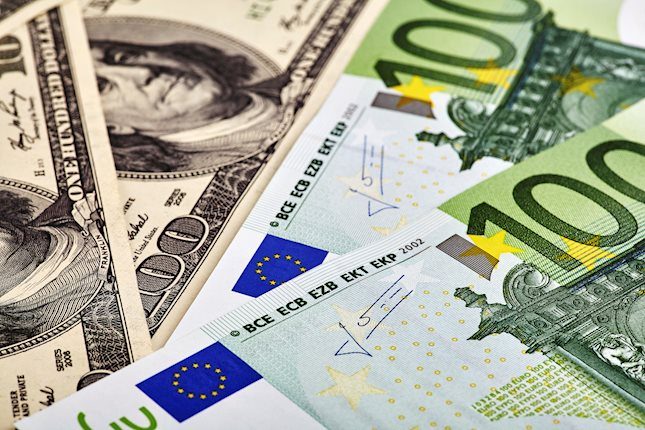In focus today
Today, focus is on the monetary policy meeting in the ECB. The ECB is widely expected to deliver a 25bp rate cut, largely because the Governing Council members have stated as much. The updated June staff projections are expected to suggest that the prevailing economic and monetary policy narrative stays broadly unchanged, and we expect the rate cut to be formulated as a rollback of the 'insurance hike' from September last year. We expect the ECB to repeat the meeting-by-meeting and data-dependent approach to the policy rate path beyond June, and we forecast the next cut only in December. For details, see ECB Preview: A political rate cut in June, and no cut in September, 24 May.
Also in Europe, the election for the European Parliament kicks off today in the Netherlands. Over the weekend the remaining member states will vote, and we will have a result of the election on Sunday evening.
In Denmark, we expect Nationalbanken to lower interest rates by 25bp as well, if ECB acts as we expect and lowers interest rates.
Overnight, China releases trade data for May. After a weak print in April, we look for a rebound in the annual growth rate as base effects turn more positive in May.
Economic and market news
What happened overnight
In Japan, Bank of Japan's (BoJ) Nakamura said that based on current data it is appropriate for BoJ to maintain monetary policy intact for the time being. Further, he added that he sees a risk that if consumption weakens further it may discourage firms from raising prices, and that this could lead to inflation falling short of the 2% inflation target from 2025 and onwards.
What happened Wednesday
In the US, non-manufacturing ISM showed a very sharp uptick as it increased to 53.8 in May (cons: 50.8, prior: 49.4). Notably for monetary policy prices index declined further (58.1; from 59.2). Employment index rose slightly (47.1; from 45.9) but remains below the neutral level of 50. Both ISM and PMI pointed towards stronger services activity in May.
The Bank of Canada (BoC) lowered its interest rate by 25 bp to 4.75% at its monetary policy meeting. The move was in accordance with market's pricing in an 84% probability of a rate cut at the meeting. Governor Macklem said that they have seen further and sustained evidence that underlying inflation is easing, and that monetary policy therefore no longer needs to be as restrictive. Furthermore, the BoC does not rule out that more rate cuts could be on the horizon if inflation continues to head in the right direction. Markets price in a 40% probability of a cut already at the next meeting in July. USD/CAD rose close to a full figure upon announcement. Since then, USD/CAD is back at the point from before the announcement.
The National Bank of Poland (NBP) kept interest rates unchanged at 5.75% at Wednesday's monetary policy meeting, in line with market consensus. The inflation rate is back in the target range of 2.5% plus or minus one percentage point. However, there are some uncertainties on where inflation is headed since the polish government are planning to raise a cap on power prices in the second half of 2024, which according to the NBP could send inflation back above 5% at the end of the year.
In Japan, the nominal wage growth increased by 2.1% in April compared to same month a year ago. This means that in real terms Japanese wages fell 0.7% y/y, declining at a slower pace than in previous periods. We still want to see an effect of the solid spring wage hikes in the wage- and inflation data, which would allow the Bank of Japan to begin hiking rates further.
In China, the Caixin services PMI for May landed at 54.0 (cons: 52.6, prior: 52.5), much higher than expected. The number indicates that the Chinese service sector production is expanding at the highest pace in 10 months.
What happened Tuesday
In the US, President Biden announced tighter measures to curb illegal immigration on the US southern border. Officials from the Biden administration said that immigrants who illegally crossed the US-Mexican border would be ineligible for asylum until the number of daily encounters is below 1500. Currently it is above 2500 a day. Illegal immigration flow has already come down quite a bit from the peak seen in H2 2023. This seems consistent with the fact that the boom in foreign born labour force growth seen earlier has moderated a bit in March and April. We have previously flagged that this could be a factor to consider if we start to see weaker headline NFP growth towards the end of the year.
Speaking of the US labour market we saw another downside surprise in job openings with negative revisions (8.06M; prev. month revised to 8.36M from 8.49M). Weaker labour demand has been a decent leading indicator for cooling wages as well.
In Switzerland, May inflation came in at 1.4% y/y (cons: 1.4%, prior: 1.4%) and core inflation at 1.2% y/y (cons: 1.3%, prior: 1.2%). With April inflation at 1.37 and May inflation at 1.39, inflation is on track to meet the SNB's Q2 inflation forecast of 1.4%. Importantly, the monthly momentum in both core and headline ticks lower to 0.1% m/m SA in headline and 0.1% in core. EUR/CHF slightly higher on the lower core measure and decreased monthly momentum.
Equities: Global equities were higher yesterday with several new all-time high closings and US indices ending at or near their daily highs. Benign macro data and five consecutive sessions of lower yields have fuelled risk appetite. Two interesting points from yesterday include a sizeable cyclical outperformance, which is logical given the data and the increase in risk appetite. Additionally, the tech sector rose 2.5% globally yesterday, with NVDA once again standing out. While this might raise curiosity and concern, it is a classic feature of late-cycle exuberance. Going against strong trends in the current environment can be extremely costly, and using a valuation approach is worthless as a timing tool. In the US yesterday, Dow +0.3%, S&P 500 +1.2%, Nasdaq +2.0%, Russell 2000 +1.5%. Asian markets are mostly higher this morning, and futures are higher in both Europe and the US as well.
FI: Yesterday, global bond yields declined as the sentiment regarding the Federal Reserve is changing slowly as market participants are changing their views on rate cuts from the Federal Reserve. 10Y US Treasury yields fells some 5-6bp yesterday, while 2Y US Treasury fell some 5bp. Furthermore, there was also a decent rally in the European government bonds with a broad-based decline in the yields.
FX: In a quiet session yesterday the most notable developments were the move higher in USD/JPY despite the rally in US Fixed income and the relatively modest move in CAD despite Bank of Canada's first rate cut. Both EUR/SEK and EUR/NOK moved very little while EUR/USD edged marginally lower as we head into today's ECB meeting, which we do not expect will rock the single currency.
This publication has been prepared by Danske Bank for information purposes only. It is not an offer or solicitation of any offer to purchase or sell any financial instrument. Whilst reasonable care has been taken to ensure that its contents are not untrue or misleading, no representation is made as to its accuracy or completeness and no liability is accepted for any loss arising from reliance on it. Danske Bank, its affiliates or staff, may perform services for, solicit business from, hold long or short positions in, or otherwise be interested in the investments (including derivatives), of any issuer mentioned herein. Danske Bank's research analysts are not permitted to invest in securities under coverage in their research sector.
This publication is not intended for private customers in the UK or any person in the US. Danske Bank A/S is regulated by the FSA for the conduct of designated investment business in the UK and is a member of the London Stock Exchange.
Copyright () Danske Bank A/S. All rights reserved. This publication is protected by copyright and may not be reproduced in whole or in part without permission.
Recommended Content
Editors’ Picks

AUD/USD continues soft as markets digest employment data
The AUD/USD declined by 0.34% to 0.6470 in Thursday's session, extending its decline to a fresh three-month low of 0.6460. The US Dollar is easing after mixed data, while weak Australian employment data has reduced inflationary concerns, which might change the outlook of the Reserve Bank of Australia.

EUR/USD: Further declines remain well in store
EUR/USD briefly tested fresh year-long lows on Thursday, piercing the 1.0500 handle for the first time in 54 weeks. A lack of meaningful EU data is doing very little to provide support for the Euro, and Fiber bids continue to tilt in favor of the safe haven US Dollar.

Gold falls as Powell signals Fed's patience on lowering rates
Gold recovers some ground on Thursday yet remains trading below its opening price for the fifth consecutive day, undermined by the Greenback’s advance for its own fifth consecutive day. A slightly hot inflation report in the US and solid jobs data sponsored XAU/USD’s leg down toward the 100-day SMA.

Ethereum Price Forecast: ETH could rally to $4,522 despite mixed on-chain flows among investors
Ethereum is down over 1% on Thursday following record net inflows across ETH exchange-traded funds in the past six days. Despite the bullish market outlook, $300 million worth of unstaked ETH could hit the market and cause downward pressure on prices.

Trump vs CPI
US CPI for October was exactly in line with expectations. The headline rate of CPI rose to 2.6% YoY from 2.4% YoY in September. The core rate remained steady at 3.3%. The detail of the report shows that the shelter index rose by 0.4% on the month, which accounted for 50% of the increase in all items on a monthly basis.

Best Forex Brokers with Low Spreads
VERIFIED Low spreads are crucial for reducing trading costs. Explore top Forex brokers offering competitive spreads and high leverage. Compare options for EUR/USD, GBP/USD, USD/JPY, and Gold.